I’m used to running into an oolong I’ve never heard of. It’s kind of my thing. But finding next-to-no information on a particular style of oolong is my greatest joy . . . and biggest pet peeve. It all started when I was put into contact with this guy.
This is Jeff Kovac of Four Seasons Tea – a new outfit specializing in rare and rarely-heard-of offerings from China and Taiwan. His name first popped up on my radar when Tony “World of Tea” Gebely sent me an e-mail. Shortly after that, I was contacted by Jeff himself.
At the time, I was still trying to whittle down my backlog of tea samples, and I was making some progress at it. That being said, I sort of had an unspoken moratorium on new samples put in place. I had to get through what I possessed before welcoming anything new.
That resolve didn’t last very long once I saw what he carried.
Among Four Seasons Tea’s wares was an oolong style I’d never heard of before – Lan Hua. They carried three different types to choose from. All of them hailed from the same producer in the southern part of Fujian province, China. (I.e. Not Wuyi territory.) Other than that, though, there weren’t any specifics – save for a mention that oolongs of this style were rarely sold for export.
I asked Jeff for more information, but got a coy . . .

Serves me right.
So, I took to the ol’ Internet. The term “Lan Hua” had many different translations. Sometimes it meant “magnolia”, other times it was “bouquet”, but the most sources agreed that it generally stood for “orchid”. Four Seasons Tea also used this translation.
And they weren’t kidding. There were no “orchid” oolongs from Southern Fujian to be found anywhere. The most common one I ran into was a Taiwanese oolong, produced using Wuyi cultivars. The second most frequent was a type of Dan Cong dubbed “Lan Hua Xiang”, which basically meant “floral fragrance”. But Dan Congs hailed from Guangdong province. Yep, the oolongs I had in my possession were, indeed, a rarity.
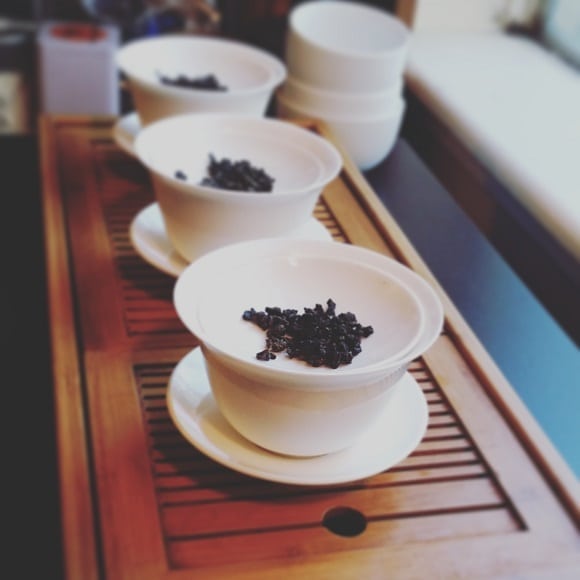
As mentioned above, Four Seasons Tea carried three different Lan Huas. One was a traditional, no frills ball-fisted one – their Lan Hua Signature. The second was a Lan Hua Signature Reserve (Grade). And the last was a charcoal-roasted/baked variety.
(Blogger’s Sidenote: Sometimes “baking” and “roasting” are used interchangeably to describe the process of putting oolongs to a fire. I have no clue which is which, or which is correct. I’ve been told one thing and/or another about the process. I eventually gave up. So, I’m just going to wing it with the descriptors. Sorry for the inconvenience.)
I started by cutting open the bag for the Signature Lan Hua.

The first thing that struck me was how tightly ball-fisted the leaves were. Many oolong styles were pressed pretty tightly, but these li’l balls were . . . well . . . little. Like leafy pebbles instead of raisins – if that makes sense. The aroma was also as floral as the namesake suggested with a sweet, buttery tingle on the backend.
The Reserve Grade was in a markedly different class than the regular Signature.

Where the regular version possessed a milder, sweeter aroma, the Reserve was straight-up flowers on the nose. It reminded me a bit of an un-roasted, autumn Tie Guan Yin. The leaves – while similar in appearance – were also greener than the regular Signature, meaning it probably had less roasting. If I were a betting man (and I’m still not), I would’ve guessed 20% less roast. But don’t quote me on that – not an expert.
The Traditional Charcoal Baked/Roasted one was the biggest surprised.
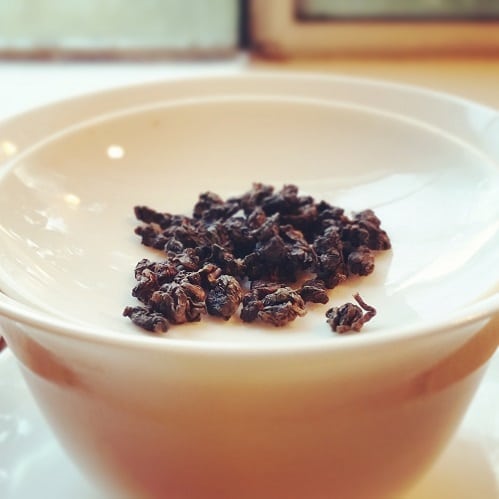
I was expecting leaves that’d been burnt to shit with an aroma of . . . stove. It was the usual impression I got from some deep roast oolongs. Definitely not the case here. In fact, this couldn’t have been further from my expectations. The leaves were, indeed, darker, but the aroma was quite similar to the regular Signature . . . just somehow deeper. More layered. I detected a lot of the Reserve’s aromatics, but more muted – not as pungent. And that sweet underpinning to the fragrance was tantalizing.
Each oolong had brewing instructions for both gaiwan gongfu and Western style approaches. I had my own way for doing multiple oolongs and puerhs, simultaneously. I brought water to a boil, set about a teaspoon of leaves of each in their own gaiwan, poured water over them, and let ‘em do their infusing thing for one minute.
The Signature Lan Hua brewed green-to-amber with an aroma that was – at first – somewhat off-putting, like burnt toast.

Closer sniffing endeared me to the toastiness, however. There was also a bit of buttered celery to the scent – slightly vegetal but not “off”-salad in that regard. The flavor was completely different from the fragrance. On first sip, I was introduced to a honey texture and taste, followed by a mineral lean in the middle, and a trail of flowers, and vanilla-butter ‘n honey. Just . . . whoah.
The Lan Hua Reserve brewed up a shade lighter than the Signature.
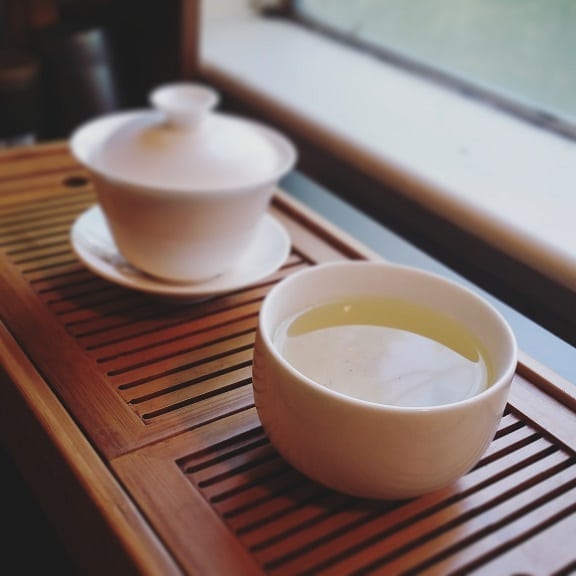
The liquor color was yellow-green, more in line with a long-brewed white tea. But in sharp contrast to the delicate color was the strong aroma. All those floral fragrances in the dry leaves translated to the finished cuppa with nary a loss. Flavor-wise, this was far “greener” tasting than the Signature. Unlike the former, this had all the “orchid” of the namesake, and not much else. There was some sweetness on the finish, a creamy lean in texture, but this was mostly aromatics in taste and smell. I totally dug it, too, but I was still fonder of the weird nuances in the Signature.
The Charcoal Baked/Roasted Lan Hua – also to my surprise – brewed light.
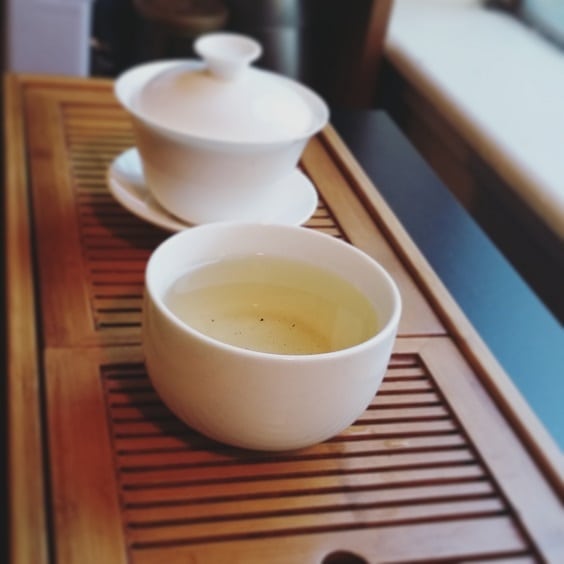
The liquor color was similar to the Reserve in palette – yellow-green, but just shy of amber. The aroma was all flowers and chestnuts. And – as expected – there was a roasty aspect to the smell. The flavor was just as nuanced, layered, and what-the-heck-ish as the Signature Lan Hua, but with the added benefit of a burly/burnt quality. No, they didn’t over-roast this, I’m just saying it tasted like . . . a bouquet of flowers you’d give to the manliest man you knew.
Which was my favorite?
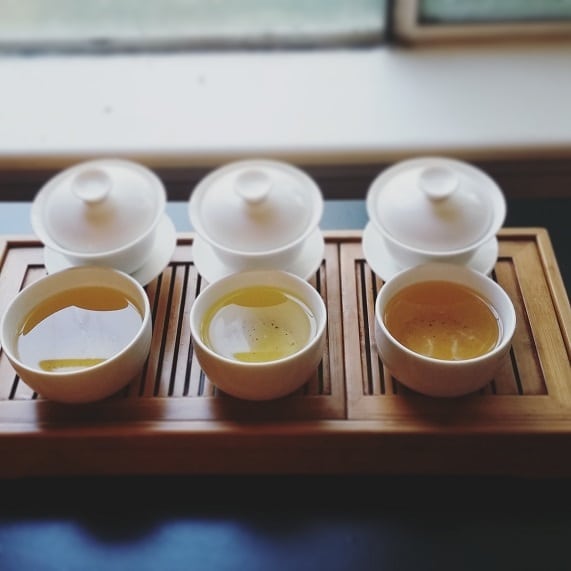
Sheesh, that’s tough. I dug them all. They were gentle in all the right places, and punchy in all the others. They were all bursting with flavors and notes, but delivered them in the best of ways – with grace and introduction. But I’m going with the regular Lan Hua. Compared to the Reserve and the Charcoaled, the Signature Lan Hua tasted like my political views – moderate, fence-sitting, but well-informed. I’m not sure that’s the best compliment to bestow, but it was the most palate subjective – like it was designed just for my odd leanings.
I wish someone would send me flowers that tasted like that.
. . . What? That’s no secret.

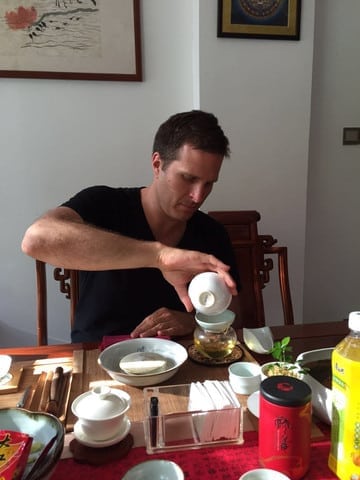
Pech
Buttered celery in a tea aroma profile that is like a salad but has a mineral flower honey flavor portion sounds unique, that’s for sure
lazyliteratus
That’s the impression I got when I was having them in real-time. Then again, my palate is a little weird.
Kelley
Did you find any difference in how the tea unfurled when it came so tightly balled?
lazyliteratus
They unfurled pretty quickly. The only one that was stubborn was – no surprise – the roasted.
Margo Hutchinson
Maybe their whole reason for being is to be a “secret”….very interesting.
lazyliteratus
No, it’s a much more mundane reason than that.
Jen
Your wonderful descriptions always make me wish I liked tea…! I’ll just have to keep living vicariously through you.
lazyliteratus
You just haven’t met the right tea, yet.
Susan | LunaCafe
Love oolong. These teas sound wonderful.
lazyliteratus
Oolongs are my go-to happy juice.
Dawne
I love me a good tea service and tea in general and this sounds interesting plus the pictures are so beautiful.
http://Www.dawnehanks.com
lazyliteratus
Thanks on all counts.
Marlynn @ UrbanBlissLife
Your descriptions, once again, are so vivid. I especially love ” tasted like . . . a bouquet of flowers you’d give to the manliest man you knew.” Thanks to your descriptions, I feel like I can smell the tea and taste it from here!
lazyliteratus
That’s the idea. Heh.
Xavier
So you didn’t find anything on this secret? So sad to hear that and to read it.
lazyliteratus
I found out a little, but can’t divulge.